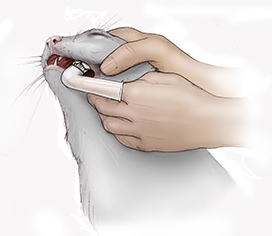Feline Dental Disease
Diseases of the teeth and gums are common in cats. Studies report that between 50 and 90% of cats older than four years of age suffer from some form of dental disease, but fortunately the most common forms of these diseases are largely preventable or treatable with appropriate preventive dental care and monitoring.
The three most common dental diseases in cats are gingivitis, periodontitis, and tooth resorption, and the severity of each of these conditions can vary significantly. Dental disease in cats can cause serious pain and discomfort, which can impact a cat’s quality of life. In many cases, dental disease causes a cat to stop eating, which leads to a variety of health problems.
Gingivitis
Gingivitis is a condition in which the gums around the teeth become inflamed (red, swollen, and painful). This inflammation is usually the result of a process that begins with the buildup of plaque, a film that harbors bacteria, on the teeth. In cats with good oral health, the bacteria that live in this film are believed to be beneficial, and the plaque that harbors them accumulates above the line where the base of the teeth meets the gums (gingiva).
If not regularly removed, plaque migrates deeper toward where the gingiva meets the base of the tooth. Eventually, plaque will migrate below this point to the subgingival region, where a cat’s immune system may mount a response to these bacteria, resulting in the inflammation that we refer to as gingivitis. Some researchers believe that the onset of gingivitis may be caused by a shift in the populations of bacteria in plaque from normal, healthy species, to disease-causing species. Tooth crowding and insufficient oral health care may contribute to plaque accumulation.
When plaque becomes hardened by absorbing minerals from both the saliva and from the gingiva itself, it is referred to as calculus or tartar. Calculus provides a rough surface that disease-causing species of bacteria can attach to. It is not the calculus itself that promotes an inflammatory response, but rather the bacteria that attach to the calculus.
Disease-causing bacteria that accumulate on and below the gums produce substances that damage the cells that form a barrier between the gums and the teeth. This allows the bacteria access to the connective tissue below the teeth where the cat’s immune system will probably react by making the gums inflamed and painful. If the cat’s immune response to these disease-causing bacteria is strong, he or she will develop gingivitis, but it is also possible the cat’s immune system will tolerate the bacteria without any detrimental effects on either.
Gingivitis may also be brought on by a number of infectious or systemic diseases, including feline leukemia virus, feline immunodeficiency virus, feline calicivirus, severe kidney disease, diabetes mellitus, and autoimmune disease. When caused by one of these systemic diseases, gingivitis may be accompanied by inflammation or sores in other parts of the pink mucous lining of the mouth, a condition known as stomatitis.
Clinical Signs/Diagnosis
Gingivitis is characterized by swelling, redness, discomfort, and, in severe cases, bleeding where the gums and the teeth meet (the gingival margin). Depending upon the severity of the gingivitis, cats may be hesitant to eat, may turn their heads unusually while eating, may stop eating, drool, or develop bad breath (halitosis). In some cases, cats with gingivitis will show a preference for soft foods.
Prevention and Treatment
The best way to prevent gingivitis in cats is to regularly remove plaque build-up by tooth brushing (see Figure 1). It is important to use only tooth gel or toothpaste designed specifically for cats, as human products can be toxic to cats. While some cats require gradual introduction before they will allow regular tooth brushing, most cats can eventually be trained to accept this preventive measure. If a cat has severe gingivitis, tooth brushing can be quite painful, so consult with a veterinarian before considering brushing the teeth of a cat with gingivitis.
Luckily for cats who have already developed gingivitis, the condition is usually reversible. The recommended treatment will depend upon how severe your cat’s case is and on the underlying cause, and may involve cleaning your cat’s teeth at home, giving him or her antibiotics (either taken as a pill or as an oral rinse), scaling of inflammation-inducing plaque from the teeth (which usually requires anesthesia), the use of immunosuppressive drugs, and in extreme cases, the removing of teeth that may serve as sources of inflammation. There is little or no evidence that treating gingivitis with antibiotics alone is effective.
In cases of feline gingivitis that are due to systemic or infectious underlying diseases, it is important to address the primary disease in order to manage the gingivitis.
Periodontitis
If gingivitis is not controlled, it can progress to periodontitis, a condition that eventually cannot be reversed. In periodontitis, the tissues that attach the tooth to the underlying gums and bone are weakened as a result of damaging substances produced by disease-causing bacteria and the inflammation caused by the cat’s own immune system.
The destruction of the tissues that attach the tooth to both the soft and bony structures that anchor the tooth may lead to loose teeth and tooth loss. Periodontitis is almost always the result of untreated gingivitis, so controlling this inciting process is crucial.
Clinical Signs/Diagnosis
Given that gingivitis leads to periodontitis, most cats with periodontitis will show signs of gingivitis (redness, swelling, bleeding along the gingiva at the base of the teeth), and may also be reluctant or unwilling to eat, drool, turn their heads to the side when chewing, and develop halitosis. In addition to these signs, they may show recession of the gingiva, exposure of tooth root surfaces, and mobility of the teeth. In extreme cases, a cat may lose one or more teeth.
A complete evaluation of cats with periodontitis involves probing the gums, and examining X-rays of the head and jaw, which require anesthesia.
Treatment
To treat feline periodontitis, your veterinarian will recommend removing plaque and mineral buildup by scaling and polishing the teeth while trying to save the teeth wherever possible. In extreme cases of periodontitis, extraction of teeth, sometimes of numerous teeth, may be required.
Tooth Resorption
Tooth resorption is a process in which the tooth structure breaks down, beginning inside the tooth, and often progressing to other parts of the tooth. Tooth resorption is the most common cause of tooth loss in cats, and between 30 and 70% of cats show some sign of this destructive process. The cause of tooth resorption is not known.
Clinical Signs
Tooth resorption in cats is usually first identified as a pinkish defect in the tooth at the line where the tooth meets the gums. By the time a defect like this shows up, the tooth is already significantly damaged. Resorptive lesions like these can vary in severity from relatively small defects at the gum line to large defects in the enamel of the tooth crown. Tooth resorption may or may not be associated with gingivitis.
Tooth resorption can be very painful, so affected cats may be reluctant or unwilling to eat, may drool, turn their heads to the side while eating, and may be irritable. Veterinarians will usually make a diagnosis by examining the mouth and teeth, carefully probing any lesions, and examining X-rays of the head and jaw, which require anesthesia.
Treatment
To treat feline tooth resorption, a veterinarian will aim to manage the cat’s pain, prevent the condition from progressing, and restore the function of the tooth or teeth as much as possible. Your veterinarian may recommend careful monitoring in cases in which lesions are limited to the tooth root and obvious discomfort is not apparent.
In cases in which a cat is showing signs of pain or discomfort and the lesions extend into the crown of the tooth, it’s best to remove the tooth. If there is significant damage, it can be difficult to extract the entire tooth. In these cases, your veterinarian may consider amputating the crown of the tooth (the part visible above the gum line). Regardless of the treatment, careful follow-up and monitoring are important.
Updated June 2017





